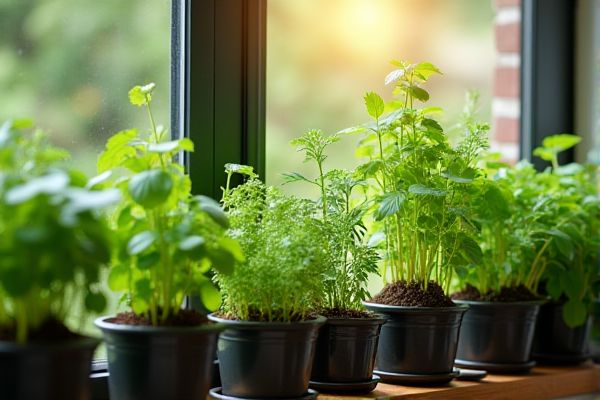
Potted herbs offer flexibility and ease of access, allowing you to move plants indoors or outdoors as needed, while a vertical herb garden maximizes space and creates a visually appealing, organized growing area. Discover which method best suits Your gardening space and lifestyle in the full article.
Table of Comparison
| Feature | Potted Herbs | Vertical Herb Garden |
|---|---|---|
| Space Efficiency | Limited to pot size; occupies horizontal space | Maximizes vertical space; ideal for small areas |
| Plant Variety | Supports fewer herbs per pot | Allows multiple herb types stacked vertically |
| Maintenance | Easy to move and water individually | May require more complex watering system |
| Growth Control | Better root space; fewer growth restrictions | Limited soil volume; can restrict root growth |
| Aesthetic Appeal | Traditional look; customizable pots | Modern, space-saving, and decorative |
| Cost | Generally lower initial cost | Potentially higher setup expense |
Introduction to Potted Herbs and Vertical Herb Gardens
Potted herbs offer a versatile and space-efficient way to grow fresh, aromatic plants indoors or on patios, ideal for small-scale kitchen gardening. Vertical herb gardens maximize limited space by utilizing wall-mounted containers or tiered systems, promoting better air circulation and easier access to multiple herb varieties. Both methods support sustainable herb cultivation, but vertical gardens often provide higher yields per square foot compared to traditional potted plants.
Space Efficiency: Which Saves More Space?
Vertical herb gardens maximize space efficiency by utilizing vertical surfaces, allowing more plants to grow in a smaller footprint compared to traditional potted herbs that occupy horizontal space. Potted herbs require individual containers spread out across shelves, windowsills, or countertops, limiting plant density. Vertical systems enable stacking or hanging multiple herb varieties, making them ideal for compact living areas or small balconies.
Setup and Installation Comparisons
Potted herbs require minimal setup, typically involving individual containers filled with soil and placed in a sunny spot, making them easy to move and rearrange according to your needs. Vertical herb gardens involve installing a structured framework--such as wall-mounted planters or vertical towers--requiring mounting space, hardware, and careful planning for irrigation and sunlight distribution. Your choice depends on available space, with potted herbs ideal for small, flexible setups and vertical gardens suited for maximizing growing area in compact environments.
Suitability for Indoor and Outdoor Environments
Potted herbs offer versatile suitability for both indoor and outdoor environments, allowing easy relocation to optimize light and temperature conditions. Vertical herb gardens excel in saving space, making them ideal for small indoor areas or urban balconies where horizontal space is limited. Your choice depends on available space and desired placement flexibility, with potted herbs providing mobility and vertical gardens maximizing area efficiency.
Accessibility and Ease of Maintenance
Potted herbs offer greater accessibility by allowing individual plants to be placed within easy reach, making watering and harvesting straightforward. Vertical herb gardens maximize space but can present challenges in reaching higher tiers, requiring step stools or ladders for maintenance. Both options require regular watering and pruning, but potted herbs simplify routine care due to their manageable size and mobility.
Cost Considerations: Initial and Ongoing Expenses
Potted herbs have lower initial costs, typically requiring only pots, soil, and seeds or starter plants, making them accessible for beginners. Vertical herb gardens involve higher initial investments due to the need for specialized structures, mounting systems, and often integrated irrigation, but they optimize space efficiently. Ongoing expenses for potted herbs include occasional repotting and soil replenishment, while vertical gardens may incur higher maintenance costs related to system repairs and water use.
Plant Variety and Compatibility
Potted herbs allow you to select individual plants based on your culinary preferences, offering flexibility in managing diverse varieties like basil, thyme, and rosemary with tailored soil and watering needs. Vertical herb gardens maximize space by growing compatible herbs in stacked layers, promoting efficient use of sunlight and air circulation but requiring careful selection to ensure plants with similar water and light requirements thrive together. Your choice between potted herbs and a vertical garden should consider plant variety and compatibility to achieve a healthy, productive herb collection.
Watering and Drainage Differences
Potted herbs require careful watering to avoid root rot, as excess water can accumulate without proper drainage holes, making it essential to use well-draining soil and pots with drainage. Vertical herb gardens often have built-in irrigation systems or drip lines that provide consistent moisture while reducing water waste, but they rely on gravity for drainage, which can cause uneven water distribution if not properly designed. Your choice depends on monitoring watering needs closely in potted herbs versus managing the integrated watering and drainage system of vertical setups.
Aesthetic Appeal and Design Options
Potted herbs offer versatile aesthetic appeal with their ability to be placed individually or grouped in creative arrangements, allowing you to customize your space easily. Vertical herb gardens maximize space by creating a striking, living wall that enhances visual interest and modern design. Both options provide unique design opportunities, but vertical gardens stand out for their ability to transform small areas into lush, eye-catching displays.
Sustainability and Eco-Friendly Aspects
Potted herbs require individual containers and frequent water use, which can increase waste and resource consumption, while vertical herb gardens maximize space efficiency and reduce water runoff through integrated irrigation systems. Vertical gardens promote biodiversity by enabling a variety of herbs to grow closely together, enhancing urban green spaces and reducing carbon footprints. Both methods contribute to sustainability, but vertical herb gardens optimize environmental benefits by conserving water and minimizing soil erosion.
 homyna.com
homyna.com